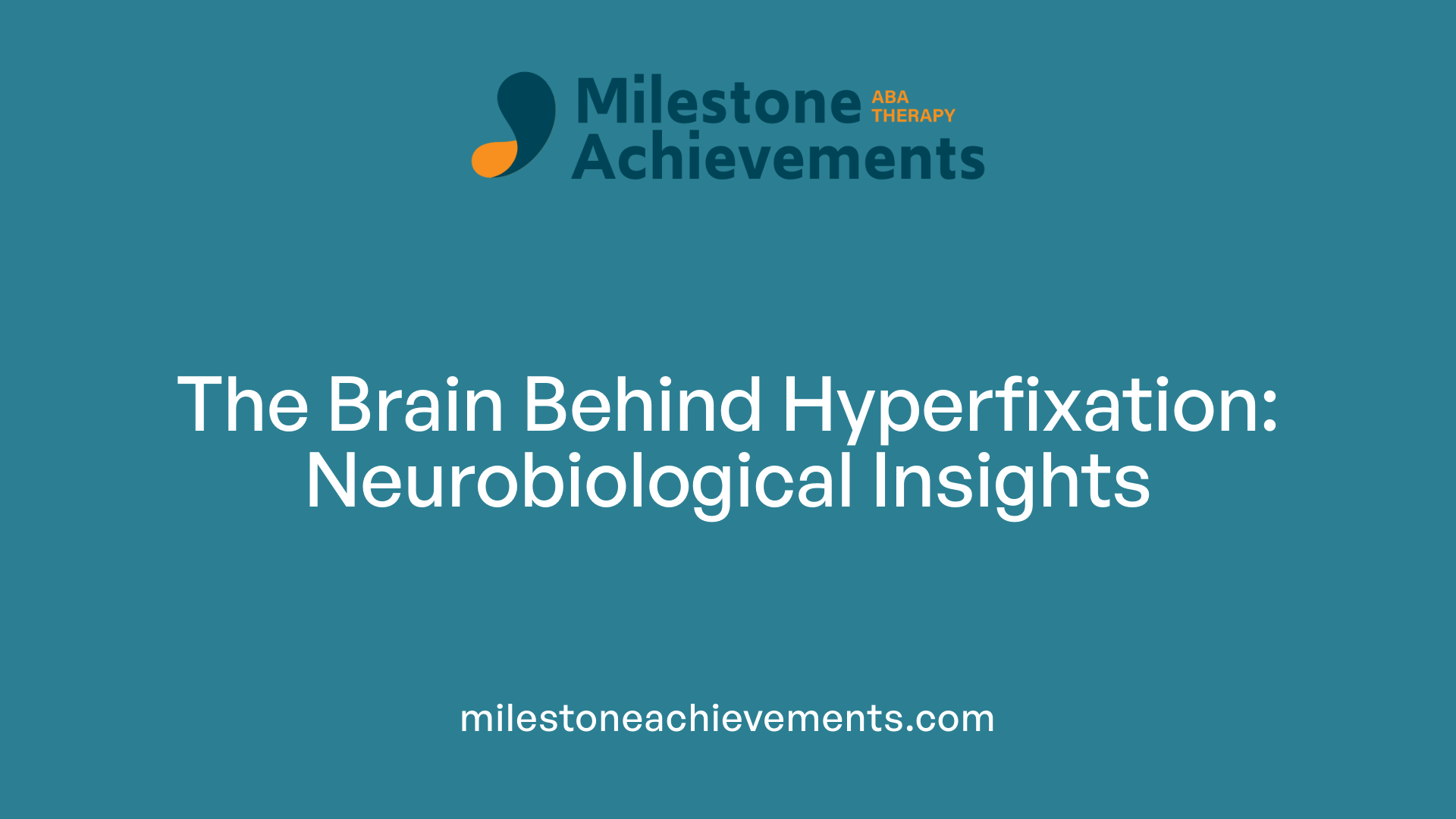
Is Hyperfixation a Symptom of Autism
Unraveling the Complexities of Hyperfixation in Autism
Understanding Hyperfixation and Its Connection to Autism Spectrum Disorder
Hyperfixation is a common yet often misunderstood aspect of neurodivergent behavior, particularly in autism spectrum disorder (ASD). It involves an intense and sustained focus on a specific interest, activity, or object, which can influence various facets of daily life. This article delves into the nature of hyperfixation, its relationship with autism, distinguishing it from similar phenomena in other conditions like ADHD, and explores whether hyperfixation can serve as an indicator of autism or occur independently.
What is Hyperfixation and Its Definitions

What is hyperfixation, and how is it related to autism spectrum disorder?
Hyperfixation is a state of intense and focused attention on a specific topic, activity, or interest. It involves a deep immersion that can last for extended periods, often leading individuals to ignore other responsibilities or social cues.
In autism spectrum disorder (ASD), hyperfixation is explicitly recognized within diagnostic criteria. It manifests as highly restricted, fixated interests that are unusually intense or narrowly focused, often seen as a core feature of autism. These interests can be diverse, ranging from animals and numbers to specific hobbies like video games or fictional worlds.
This form of focus results from neurodivergent processing, where autistic brains tend to develop monotropic attention and pattern recognition. Such hyperfixations can foster expertise and emotional comfort, serving as tools for self-regulation. However, they can also create challenges, including difficulties in shifting attention, social interactions, and fulfilling daily routines.
Overall, hyperfixation in autism highlights a different way of engaging with the world—one characterized by deep, sometimes all-consuming interests that influence learning, socialization, and daily functioning.
Characteristics of hyperfixation
- Deep and sustained focus on a particular subject or activity
- Often involves extensive knowledge or repetitive behaviors
- May lead to neglect of basic needs like eating, drinking, or resting
- Can foster skill development and expertise over time
- Acts as a coping mechanism to reduce anxiety or sensory overload
- Marks a preference for specific themes such as animals, technology, or fictional universes
Difference from hyperfocus
While hyperfocus is a term often used to describe a short-term, intense concentration on a task, hyperfixation typically refers to a longer-lasting preoccupation. Hyperfixations can persist over weeks, months, or even years, significantly influencing daily life and routines. In contrast, hyperfocus is usually brief and task-specific, though both involve heightened attention and can be difficult to shift away from.
Neurobiological Foundations of Hyperfixation

What does an autistic hyperfixation look like?
Autistic hyperfixation manifests as an intense and sustained focus on a specific interest, topic, or activity. Individuals may spend hours or even weeks immersed in their chosen focus, often neglecting basic needs such as eating, sleeping, and self-care. They might ignore social interactions and have difficulty transitioning to other activities.
This deep engagement can lead to significant skill development, a rich knowledge base, and emotional comfort. However, it may also cause frustration or agitation if interrupted or if their focus is disrupted. For example, a child deeply engrossed in a particular TV show or collecting specific items might not respond to their name or other social cues.
Signs include repetitive behaviors around their interest, limited communication about other topics, and a strong preference for routines related to their fixation. While hyperfixation can pose challenges in daily life, it also offers opportunities for growth when supported appropriately.
Understanding the neurological basis of hyperfixation helps us see it not just as a compulsive behavior but as a manifestation of how specific brain regions and neurochemical processes operate.
Hyperfixation in Autism versus Other Conditions

Is hyperfixation a specific symptom of autism or ADHD?
Hyperfixation is a phenomenon characterized by an intense, sustained focus on a specific topic, activity, or object, often to the exclusion of other needs and responsibilities. It is commonly observed in individuals with autism spectrum disorder (ASD) and attention-deficit/hyperactivity disorder (ADHD), with autism explicitly acknowledging hyperfixation as a characteristic feature in its diagnostic criteria.
While hyperfixation can occur in neurotypical individuals and may sometimes have positive effects, such as fostering expertise or passion, it can also lead to neglect of self-care and social interactions when excessive. It differs from hyperfocus, which is a deep concentration on a task that can happen in various contexts and is often short-term; hyperfixation tends to be more persistent and obsessional.
Overall, hyperfixation is not exclusive to autism or ADHD but is more prominent and intense in these neurodivergent conditions, serving as both a potential strength and a challenge depending on the context.
How does hyperfixation compare between autism and ADHD?
Children and adults with autism often experience hyperfixation as an intense, full immersion in specific interests, such as animals, patterns, or fictional worlds. These interests can dominate their thoughts, influence their routines, and sometimes lead to neglect of social interactions and basic needs.
In individuals with ADHD, hyperfixation appears as episodes of highly focused attention on preferred activities or subjects. These periods can last for extended times but are generally linked to dopamine-driven reward systems that reinforce engagement. Unlike autistic hyperfixation, which tends to be more obsessive, ADHD hyperfixation is often more variable and may fluctuate with shifts in motivational states.
Shared traits in neurodivergence
Despite differences, both conditions feature hyperfixation as a form of deep, sustained attention. In both cases, this preoccupation can bolster skills and knowledge, sometimes leading to expertise or career focus. Additionally, hyperfixation can serve as a coping mechanism for stress, sensory overload, or social difficulties.
However, challenges such as difficulty transitioning out of hyperfixation, neglect of daily responsibilities, and emotional distress during interruptions are common across both conditions.
| Aspect | Autism | ADHD | Commonalities |
|---|---|---|---|
| Typical interests | Deep focus on specific interests like animals, patterns, or hobbies | Focus on preferred activities, often with a reward-driven cycle | Extended, intense engagement with interests |
| Impact on daily life | Can lead to neglect of self-care and social interactions | Can interfere with daily responsibilities | Both can affect social, occupational, or personal functioning |
| Duration | Often long-term, persistent | Can be episodic or fluctuating | Both involve sustained focus but differ in intensity and consistency |
| Benefits | Development of expertise, stress relief | Skill development, motivation | Potential for personal growth and mastery |
| Challenges | Social isolation, neglect of needs | Difficulty shifting focus, frustration | Both require support for balance and well-being |
Understanding these shared and distinct features underscores the importance of recognizing hyperfixation as a complex, multifaceted trait. Support strategies that respect individual differences can help turn hyperfixation into a positive force for growth and development.
Recognizing Hyperfixation in Children and Adults

Signs and behaviors
Hyperfixation manifests through specific signs and behaviors that are often noticeable to parents, teachers, or caregivers. Individuals may display extensive knowledge about a particular subject, engaging in repetitive activities associated with that interest. They may become fully immersed in their preferred activity, often ignoring surrounding stimuli or social interactions.
Children and adults experiencing hyperfixation tend to prioritize their focus area over other responsibilities, deliberately or unconsciously neglecting daily tasks like eating, sleeping, or hygiene. They might also exhibit repetitive behaviors related to their focus, such as rereading a favorite book or obsessively practicing a skill.
Duration and intensity
The duration of hyperfixation can vary significantly. It may last days, weeks, or even months, with some individuals maintaining a deep focus for extended periods. The intensity is often high, leading to an all-consuming engagement that can restrict awareness of time and surroundings.
In autism, hyperfixation involves a profound, full immersion in a subject or activity, often leading to significant neglect of other areas of life. The level of focus can be so intense that shifting attention becomes difficult, sometimes requiring deliberate strategies to help transition.
Impact on daily life
While hyperfixation can foster deep learning and skill development, it can also interfere with daily activities and responsibilities. Individuals may neglect self-care, miss social opportunities, or struggle with transitions between activities.
In some cases, hyperfixation leads to emotional distress or frustration if interrupted or prevented from engaging with their interest. It can cause social isolation, especially if others do not share or understand the focus.
What does an autistic hyperfixation look like?
Autistic hyperfixation typically involves a prolonged, intense focus on a specific interest, such as animals, numbers, fictional worlds, or technology. This focus can last for weeks or months, during which the individual may dedicate vast amounts of time to exploring, practicing, or talking about their obsession.
Signs include ignoring basic needs, limited social engagement, and a tendency to become upset if their focus is disrupted. Despite some challenges, these interests often help build expertise and provide comfort, serving as a vital coping mechanism.
Understanding these behaviors helps recognize hyperfixation as a natural part of neurodivergence. When supported appropriately, hyperfixation can be channeled into positive growth, learning, and social connection.
The Benefits and Challenges of Hyperfixation

What are the potential benefits and drawbacks of hyperfixation?
Hyperfixation is a profound focus on a specific interest, activity, or item that can last for extended periods. On the positive side, it often results in developing a high level of knowledge or skill, sometimes leading to expertise that can influence career choices or hobbies. It can foster confidence, as mastering interests strengthens self-esteem. For many, hyperfixation provides emotional comfort and acts as an effective coping strategy during stressful times, sensory overload, or social anxiety.
However, there are notable challenges associated with hyperfixation. It can cause neglect of basic needs like eating, drinking, or personal hygiene, impacting overall health. It might interfere with daily routines, responsibilities, and social interactions, leading to social isolation or misunderstandings. Intervention disruptions during hyperfocus episodes often trigger frustration, agitation, or emotional distress.
To manage hyperfixation positively, it’s crucial to support interests while setting healthy boundaries. Practical strategies include using timers, visual schedules, and integrating their focus areas into learning and social activities. When balanced correctly, hyperfixation transforms from a potential obstacle into a powerful resource for personal growth, skill development, and emotional resilience. By understanding and supporting this trait, individuals can turn hyperfixation into an enriching and empowering part of their lives.
Strategies for Supporting Hyperfixation

How can caregivers and educators support individuals with hyperfixation?
Supporting those with hyperfixation involves understanding and appreciating their intense focus. Recognizing that hyperfixation can have both positive and negative impacts is essential for effective support.
One of the first steps is to validate their interests. By acknowledging their passions, caregivers and educators can foster self-esteem and motivation. For instance, if a child shows an intense interest in animals, encouraging exploration and learning within that area can boost confidence.
To help manage hyperfixation realistically, setting boundaries is crucial. This can be achieved through the use of timers and visual schedules that regulate how much time is spent on particular interests. These tools can prevent neglect of basic needs like eating, sleeping, or attending to responsibilities.
Another helpful strategy is integrating hyperfixated topics into educational and social activities. For example, incorporating a child's love for video games into lessons or group projects can make learning more engaging. Such approaches turn interests into opportunities for skill development and social interaction.
Gradual transitions are also important. Preparing individuals for change reduces frustration and agitation. For example, giving advance notice before shifting from a favored activity can ease the transition.
Finally, emphasizing strengths and encouraging skill development within hyperfixations can lead to positive outcomes. Turning a focused interest into a potential career path or hobby can provide a sense of achievement and purpose.
By creating supportive environments that respect and harness hyperfixation, caregivers and educators can promote well-being, foster growth, and help individuals channel their focus productively.
Hyperfixation as a Resource and Not a Problem

Turning hyperfixation into an advantage
Hyperfixation often involves long periods of deep engagement with a specific interest, which can have remarkable benefits. For example, individuals may develop expertise in areas like animals, technology, history, or hobbies, sometimes even choosing careers aligned with their intense interests. This focus can lead to skill mastery and confidence-building. Embracing hyperfixation allows individuals to harness their dedication positively, turning what might seem like a distraction into a pathway for personal growth.
Personal growth and education
Hyperfixation provides a fertile ground for learning and skill development. Because these interests are pursued with sustained attention, individuals often accumulate extensive knowledge and improve their abilities in particular areas. For children, hyperfixation can motivate them to explore topics deeply, enhancing their education. For adults, it can open new avenues for career advancement or hobbies. Supporting hyperfixation by integrating interests into learning and development strategies makes education more engaging and effective.
Building social skills
While hyperfixation can sometimes lead to social challenges, it can also be a bridge to connection. Sharing one’s interests with others could foster social interaction, especially within communities that celebrate specific hobbies or topics. To do this effectively, it’s important to encourage balance—validating interests while also developing communication skills and social awareness. Using interests as conversational starters or social activities can help reduce feelings of isolation and promote meaningful relationships.
Additional insights
| Aspect | Description | Impact |
|---|---|---|
| Development of expertise | Deep focus on interests leads to skill mastery | Confidence, career opportunities |
| Emotional regulation | Hyperfixation can soothe anxiety and provide comfort | Stress relief, emotional stability |
| Challenges | May interfere with daily routines | Need for support and boundaries |
| Strategies | Embrace, set timers, incorporate interests into activities | Manage hyperfixation positively |
It is important to recognize hyperfixation not as a problem but as a potential resource. When supported appropriately, it can enrich lives through learning, personal development, and social connection, turning a neurodivergent trait into a powerful asset.
Conclusion: Embracing Hyperfixation in Autism Spectrum Disorder

What are the main points about hyperfixation?
Hyperfixation involves an intense and prolonged focus on a specific subject, activity, or item. It often manifests in individuals with autism, characterized by full immersion and a deep knowledge of particular interests such as animals, technology, or fictional worlds. While hyperfixation can lead to skill development, expertise, and a sense of purpose, it may also cause neglect of personal needs, social interactions, and responsibilities.
Research shows that hyperfixation impacts brain activity, with increased activity in the left frontal lobe and decreased in the right frontal lobe. This neuroactivity reinforces focus through dopamine release, making shifting interests challenging. Although hyperfixation can sometimes be problematic—hindering daily routines or social connections—it also provides emotional comfort, helps manage stress, and boosts confidence.
In terms of behavior, signs include extensive knowledge, repetitive behavior, and deep engagement. Supporting individuals with hyperfixation involves validating their interests, setting gentle boundaries, and using strategies like timers or visual schedules to balance focus with other needs.
Why is understanding hyperfixation important?
Understanding hyperfixation within neurodivergent populations, especially autistic individuals, is essential because it reframes this trait from a problem to a potential strength. Recognizing that hyperfixation can foster deep learning, expertise, and emotional regulation allows caregivers and educators to harness its benefits.
Supporting hyperfixation responsibly involves emphasizing personal growth, offering opportunities for skill-building, and encouraging social connection through shared interests. Proper management can turn hyperfixation into a resource rather than a barrier, promoting well-being and resilience.
Does hyperfixation indicate autism?
Hyperfixation is commonly observed in people with autism, but it is not exclusive to autism. It can also be present in individuals with ADHD or other neurodivergent conditions, or even in neurotypical people. The presence of hyperfixation alone does not confirm an autism diagnosis. Autism is characterized by a range of behaviors, including social communication challenges and repetitive behaviors, with hyperfixation being just one aspect.
Understanding hyperfixation's role and how it interacts with other traits helps foster a compassionate approach. Recognizing its strengths and challenges guides better support strategies, making it clear that hyperfixation, when managed well, can be a powerful tool for personal development and enrichment.
Final Thoughts on Hyperfixation and Autism
Understanding hyperfixation is crucial in recognizing the diverse ways neurodivergent brains operate. While hyperfixation is a hallmark feature in many autistic individuals, it is a behavior that extends beyond autism—also appearing in ADHD, other conditions, and even neurotypical people under specific circumstances. Recognizing its dual nature—as both a potential strength and a challenge—helps caregivers, educators, and individuals themselves harness its positive aspects while managing its difficulties. Ultimately, hyperfixation reflects a way the brain processes and interacts with the world, offering opportunities for growth, expertise, and personal fulfillment when supported properly. Appreciating hyperfixation within a broader diagnostic and personal context fosters a more inclusive, understanding approach to neurodiversity.
References
- Understanding and Embracing Hyperfixation in ADHD and Autism
- Autism Hyperfixation: What You Need to Know
- Autistic Hyperfixation: What Parents Need to Know - Blue ABA
- Autism Hyperfixation | What It Looks Like in Kids - Goally
- Food hyperfixation, ADHD, and autism: Why you eat safe foods - Inflow
- Autism Hyperfixation: What You Need to Know
- Understanding and Embracing Hyperfixation in ADHD and Autism


Partner with us on your child's journey
Milestone Achievements offers evidence-based ABA therapy to help children with autism reach their full potential. Together we’ll set meaningful goals and celebrate progress every step of the way.
Start ABA Services Today


